Brother MFC-795CW Wireless All-in-One Inkjet Review
Brother MFC-795CW Wireless All-in-One Inkjet
The Brother MFC-795CW inkjet printer is certainly a jack of all trades but does it master them all?
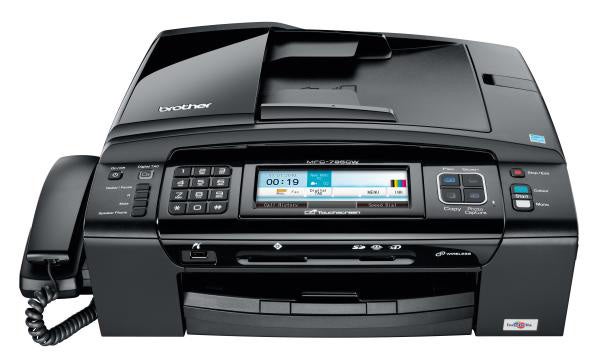
Verdict
Key Specifications
- Review Price: £178.70
If you look at the Brother site, you’ll see 15 different all-in-one inkjet printers, most of which bear more than a passing resemblance to the MFC-795CW. All of the main printer makers are trying to rationalise their ranges by employing the same or similar print engines throughout and differentiating between them by feature set.
This machine has three outstanding features to separate it from others in the range. It links wirelessly, as well as by Ethernet or USB, has a responsive, easy-to-use touchscreen and it includes a phone handset and built-in telephone answering machine, as well as fax. This makes it a good fit in any office with restricted space, as it can handle most of the main office tasks in one compact unit.
All decked out in black, with a wide-aspect touchscreen for most controls and a neatly styled Automatic Document Feeder (ADF) built into the scanner lid, the machine also sports sockets for the main memory card types and a dual-purpose socket for PictBridge cameras and USB drives.
The main paper tray can take up to 100-sheets of plain paper and has a 20-sheet photo paper tray piggybacked on top, though you have to push this into the machine manually when switching to photo print. 15 x 10cm photos don’t quite eject from the front of the MFC-795CW and you have to go foraging to fetch them out.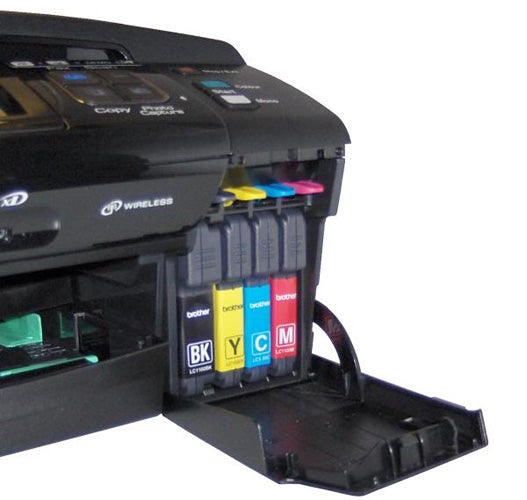
The four ink cartridges plug in behind a cover to the right of the paper trays, which is very convenient, and the bundled software, which includes Brother’s own multifunction software and a copy of Nuance PaperPort, installs easily. There are drivers for Windows and OS X and Brother is keen to point out that these work with Windows 7 and Snow Leopard.
Of all the silly inkjet speed claims made by printer makers, Brother’s are the furthest from reality. OK, they may be for draft print, exclude processing time and use an idealised test document, but they bear so little relation to what you’ll see in typical use as to be worthless.
Brother claims this machine can print 35 mono pages or 28 colour ones per minute. We didn’t see one tenth of these speeds. Our five-page black text document took 1min 46s to complete, which is equivalent to a speed of 2.83ppm. The longer, 20-page test took 6mins 45s, or 2.96ppm and the five-page black text and colour graphics job took 2mins 5s, or 2.40ppm.
For comparison, equivalently priced machines from Epson (Stylus Photo PX710W), HP (Photosmart Premium C309g) and Lexmark (Prevail Pro705) had five-page black speeds of 6.67ppm, 7.89ppm and 3.90ppm and five-page text and colour graphics speeds of 6.00ppm, 4.00ppm and 3.70ppm. The MFC-795CW is a very slow all-in-one.
The print quality is nothing special, either. Black text is fuzzy and jagged and ink saturation is poor, so the white paper fibres show through in places, giving the text a dark grey, rather than fully black appearance.
Colours on plain paper, while looking a little anaemic, are smoothly laid onto the paper, with no signs of banding and good colour fidelity. Black text registration over colour is also good. A full-colour copy reproduces colours quite well, though again paler than in the originals.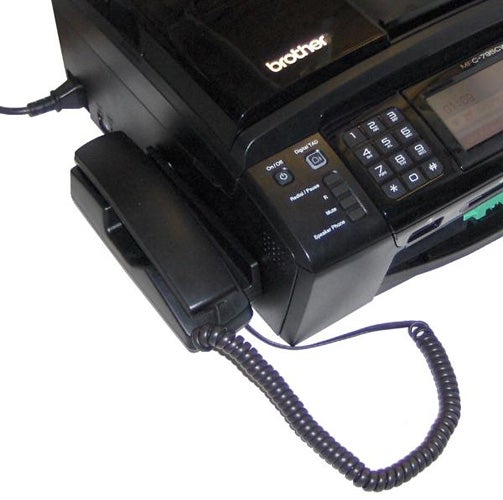
Photographic prints, on Brother’s own glossy photo paper, are well detailed and include smooth colour transitions and reasonably natural colourings. Shadow detail is spoiled by some loss of definition as darker shades tend to black.
Although the machine is well provided with assistance screens to help sort out any problems, it’s a bit too keen for you to follow them. For example, if you try to print and the MFC-795CW runs out a paper, it demands you refill the paper tray and won’t let you cancel the error condition until it has completed the job. If you decide not to finish the print task, you have to turn the printer off and on again to make it forget – the Stop/Exit button has no effect.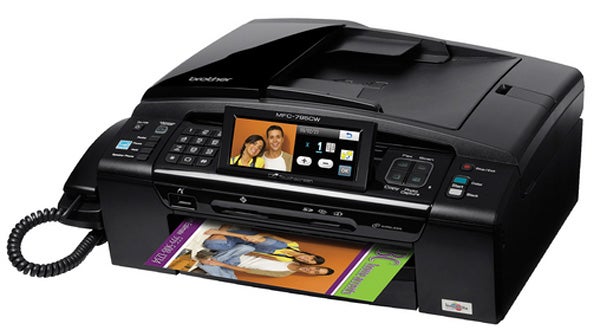
The MFC-795CW can only use the standard-yield LC-1100 series cartridges, while some other machines in the range can also take the HY versions. This limits the economy you can achieve with the machine, though in its intended market this may not be a problem.
You can get slightly better costs by buying the four cartridges in a bundle pack and we’ve used this to calculate page costs, which come out at 3.72p for an ISO black page. This makes it more expensive to run than the Epson and HP machines we’ve referred to on the previous page, though around one penny per page less than the Lexmark.
The colour page cost comes out at 10.64p, which is again more expensive than the Epson and HP, nearly 3p per page more in the case of comparison with the HP Photosmart Premium C309g.
”’Verdict”’
While the fax and phone – complete with answering machine – may be a useful adjunct to the core features of print, scan, copy and photo transfer, it’s hard to recommend the MFC-795CW because its underlying print facilities are slow and print quality, certainly on plain paper, is less than ideal. Brother sells a lot of this style of inkjet all-in-one, so there must be a market for convenience over ultimate print quality, but we’d advise looking carefully at the competition.
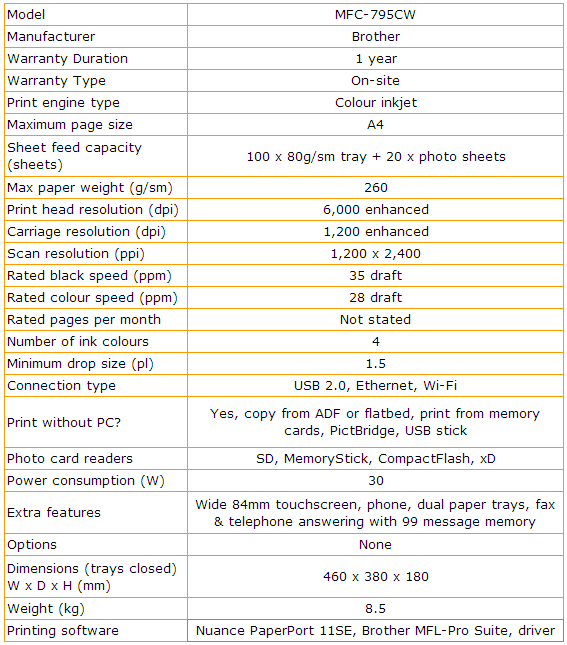
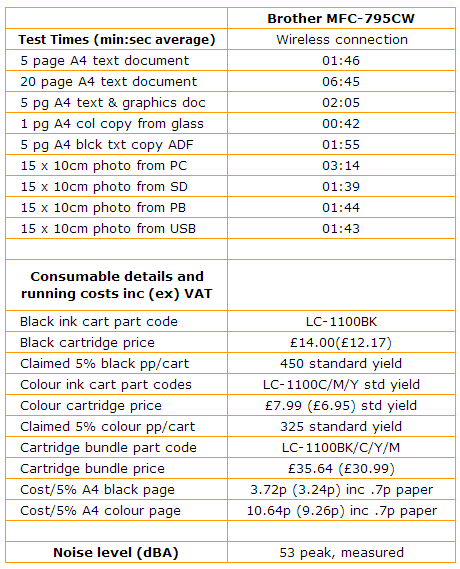
Trusted Score
Score in detail
-
Print Speed 5
-
Features 8
-
Value 7
-
Print Quality 6
Features
| Networking | Ethernet (10/100 Mbps), Wireless Ethernet - IEEE802.11b, Wireless Ethernet - IEEE802.11g, Fast Ethernet, Wi-Fi |
| Card slot | CompactFlash, Memory Stick, Memory Stick PRO, SD Card, SDHC Card, USB Flash Drive, xD-Picture Card |
Printing
| Paper Size | A4, Letter, Legal, Executive, B5 (JIS), A5, A6, 4" x 6", Index Card - 5" x 8", 2L - 5" x 7", Postcard - 3.94" x 5.83", Double Postcard - 5.83" x 7.87", C5 Envelope, Com10 Envelope, DL Envelope, Monarch Envelope, JE4 Envelope, Letter - 216 mm x 297 mm, 102 mm x 152 mm, 89 mm x 127 mm, 127 mm x 178 mm, 127 mm x 203 mm, 203 mm x 254 mm, 216 mm x 356 mm |
| Sheet Capacity | 100 sheets |
| Rated Black Speed (Images per minute) | 35 ppmipm |
| Rated Colour Speed (Images per minute) | 28 ppmipm |
Scanning
| Scan Resolution (Dots per inch) | 1200 dpi, 1200 x 2400dpi |

